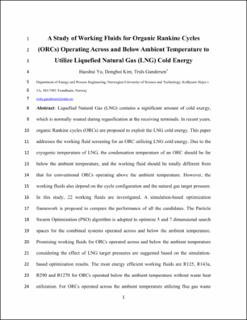| dc.contributor.author | Yu, Haoshui | |
| dc.contributor.author | Kim, Donghoi | |
| dc.contributor.author | Gundersen, Truls | |
| dc.date.accessioned | 2020-03-25T10:03:34Z | |
| dc.date.available | 2020-03-25T10:03:34Z | |
| dc.date.created | 2019-04-30T12:54:14Z | |
| dc.date.issued | 2019 | |
| dc.identifier.citation | Energy. 2019, 167 730-739. | en_US |
| dc.identifier.issn | 0360-5442 | |
| dc.identifier.uri | https://hdl.handle.net/11250/2648514 | |
| dc.description.abstract | Liquefied Natural Gas (LNG) contains significant amounts of cold exergy, which is normally wasted during regasification at receiving terminals. This paper addresses working fluid screening for Organic Rankine Cycles (ORCs) utilizing LNG cold energy. Due to the cryogenic temperature of LNG, the condensation temperature of an ORC should be far below ambient temperature, and the working fluid should be totally different from conventional ORCs operating above ambient temperature. However, the working fluids also depend on the cycle configuration and the natural gas target pressure. In this study, a simulation-based optimization framework is proposed to compare the performance of 22 candidate working fluids. The Particle Swarm Optimization (PSO) algorithm is adopted to optimize 5 and 7 dimensional search spaces for the combined systems operated across and below ambient temperature. Promising working fluids for ORCs considering the effect of natural gas target pressure are suggested based on the optimization results. The most energy efficient working fluids are R125, R143a, R290 and R1270 for ORCs operated below ambient temperature without waste heat utilization. For ORCs operated across ambient temperature utilizing flue gas waste heat from a natural gas fired power plant, R170, R134a and R290 perform better than other working fluids. | en_US |
| dc.language.iso | eng | en_US |
| dc.publisher | Elsevier | en_US |
| dc.rights | Attribution-NonCommercial-NoDerivatives 4.0 Internasjonal | * |
| dc.rights.uri | http://creativecommons.org/licenses/by-nc-nd/4.0/deed.no | * |
| dc.title | A study of working fluids for Organic Rankine Cycles (ORCs) operating across and below ambient temperature to utilize Liquefied Natural Gas (LNG) cold energy | en_US |
| dc.type | Peer reviewed | en_US |
| dc.type | Journal article | en_US |
| dc.description.version | acceptedVersion | en_US |
| dc.source.pagenumber | 730-739 | en_US |
| dc.source.volume | 167 | en_US |
| dc.source.journal | Energy | en_US |
| dc.identifier.doi | 10.1016/j.energy.2018.11.021 | |
| dc.identifier.cristin | 1694744 | |
| dc.description.localcode | © 2018. This is the authors’ accepted and refereed manuscript to the article. Locked until 9.11.2020 due to copyright restrictions. This manuscript version is made available under the CC-BY-NC-ND 4.0 license http://creativecommons.org/licenses/by-nc-nd/4.0/ | en_US |
| cristin.unitcode | 194,64,25,0 | |
| cristin.unitname | Institutt for energi- og prosessteknikk | |
| cristin.ispublished | true | |
| cristin.qualitycode | 2 | |

